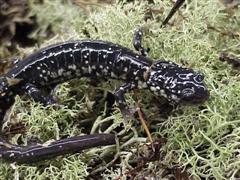Salamander - Slimly
Scientific Name: Plethodon glutinosus
Mon, 28th April, 2025 - 8:30 am GMT
Sponsor Ads:

Alternative Name
Scientific Name: Plethodon glutinosusBasic Info
Slimy Salamanders have slender bodies and can grow up to between 5 and 7 inches in length. Their skin is glossy and black. It is accented with white or brassy speckles, camouflaging the salamander so it looks like a lichen-covered stick. When males perform courtship motions, the spots turn pink and eventually red. The undersides are similarly colored, but in paler shades. They do not have any lungs; rather, Slimy Salamanders must keep their skins moist in order to use oxygen from water they absorb. Slimy Salamanders have nasolabial grooves and about 16 costal grooves.
Health
Slimy Salamanders need terrariums with lots of hiding places. A mixed soil substrate may be appropriate and can be misted regularly to maintain humidity. Make sure the salamander has a shallow water bowl that it can easily get into and out of. Slimy Salamanders should only be kept with salamanders of the same size, and if you are keeping more than one, the terrarium should be very large and should include a number of hiding or escape areas. Breeding Generally, female Slimy Salamanders are longer than males. Breeding usually occurs in the spring. Courtship involves a physical interaction in which the male rubs his tail under the females chin. He will also climb atop her and move his body rhythmically. Eventually, the male produces a spermatophore that the female must take up. She will generally lay groups of eggs in a rotting log or other damp, protected terrestrial location. There are usually 12 eggs in each group. The development period for the eggs lasts about three months. These eggs will hatch into fully developed, though lightly colored, Slimy Salamanders that will reach sexual maturity in about three years.Habitat
They are most usually found in wooded areas. Occasionally, they may be seen moving about after heavy rainfall.Behavior
The Slimy Salamander is a rather amazing creature, one of a family of lungless salamanders! Generally, Slimy Salamanders are quite secretive and remain hidden under moist leaf debris or other vegetation. Slimy Salamanders are territorial and may defend home ranges from other salamanders. Females also guard their eggs fiercely. They will eat smaller salamanders, and subsist on insects like worms and ants for the most part. Snakes may prey on Slimy Salamanders, especially weakened or ill animals. The Slimy Salamander can secrete a very thick, sticky substance from its skin, which discourages predators from consuming it. This secretion may be an irritant to human skin, as well, and can cause rashes.Origin
United StatesHistory
Slimy Salamanders are native to the eastern central regions of North America. There are actually about 13 different species of Slimy Salamander, but differences are so minimal that it is quite difficult to discern between species.Common Foods
feeds primarily on insects, earthworms, small rodents, small animals.Sponsor Ads:
Firestone's Law of Forecasting: Chicken Little only has to be right once.
Salamander - Slimly
Coded by: BGID® | ALL RIGHTS RESERVED Copyright © 2000-2025
Disclaimer | Privacy | Report Errors / Contact | Credits








 Preparing For China. China is growing their military. China Military Technology - can it keep up with the US?
Preparing For China. China is growing their military. China Military Technology - can it keep up with the US?  versus
versus 

 versus
versus 
 This Thread is about the North Korean Military itself - the kind of army, navy, and air force they have.
This Thread is about the North Korean Military itself - the kind of army, navy, and air force they have. 
 versus
versus 
 versus
versus  versus
versus